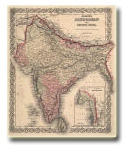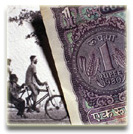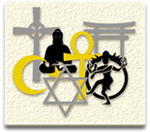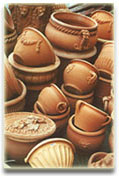Indian Holidays - Free Travel Infromation
|
|
 In the conventional narrative, Indian history begins with the birth of the Indus Valley Civilization in such sites as Mohenjo-Daro, Harappa, and Lothal, and the coming of the Aryans.These two phases are usually described as the pre-Vedic and Vedic perio ds. It is in the Vedic period that Hinduism first arose: this is the time to which the Vedas are dated. In the fifth century, large parts of India were united under Ashoka; he also converted to Buddhism, and it is in his reign that Buddhism spread to o ther parts of Asia.It is in the reign of the Mauryas that Hinduism took the shape that fundamentally informs the religion down to the present day. Successor states were more fragmented. Islam first came to India in the eighth century, and by the eleve nth century had firmly established itself in India as a political force; the North Indian dynasties of the Lodhis, Tughlaqs, and numerous others, whose remains are visible in Delhi and scattered elsewhere around North India, were finally succeeded by the Mughal empire, under which India once again achieved a large measure of political unity.
In the conventional narrative, Indian history begins with the birth of the Indus Valley Civilization in such sites as Mohenjo-Daro, Harappa, and Lothal, and the coming of the Aryans.These two phases are usually described as the pre-Vedic and Vedic perio ds. It is in the Vedic period that Hinduism first arose: this is the time to which the Vedas are dated. In the fifth century, large parts of India were united under Ashoka; he also converted to Buddhism, and it is in his reign that Buddhism spread to o ther parts of Asia.It is in the reign of the Mauryas that Hinduism took the shape that fundamentally informs the religion down to the present day. Successor states were more fragmented. Islam first came to India in the eighth century, and by the eleve nth century had firmly established itself in India as a political force; the North Indian dynasties of the Lodhis, Tughlaqs, and numerous others, whose remains are visible in Delhi and scattered elsewhere around North India, were finally succeeded by the Mughal empire, under which India once again achieved a large measure of political unity.
Geography: Total land area in India - 2,973,190 square kilometers.Total area, including territorial seas, claimed is 3,287,590 square kilometers.India is home to several major rivers such as the Ganga (Ganges), the Brahmaputra, the Yamuna, the Godavari, and the Krishna.
The Indian climate varies from a tropical climate in the south to a more temperate climate in the north. India gets its rains through the monsoons.
Geographic coordinates: 20 00 N, 77 00 E
Land boundaries:
total: 14,103 km
border countries: Bangladesh 4,053 km, Bhutan 605 km, Burma 1,463 km, China 3,380 km, Nepal 1,690 km, Pakistan 2,912 km
Coastline: 7,000 km
lowest point: Indian Ocean 0 m
highest point: Kanchenjunga 8,598 m
Total land area in India - 2,973,190 square kilometers.Total area, including territorial seas, claimed is 3,287,590 square kilometers.India is home to several major rivers such as the Ganga (Ganges), the Brahmaputra, the Yamuna, the Godavari, and the Krishna.
The Indian climate varies from a tropical climate in the south to a more temperate climate in the north. India gets its rains through the monsoons.
Geographic coordinates: 20 00 N, 77 00 E
Land boundaries:
total: 14,103 km
border countries: Bangladesh 4,053 km, Bhutan 605 km, Burma 1,463 km, China 3,380 km, Nepal 1,690 km, Pakistan 2,912 km
Coastline: 7,000 km
lowest point: Indian Ocean 0 m
highest point: Kanchenjunga 8,598 m
Economy:  India has had robust economic growth since 1991 when the government reversed its socialist-inspired policy of a large public sector with extensive controls on the private sector and began to liberalize the economy.Liberalization has proceeded in fits and starts since then, mainly due to political pressures, but the economy has responded well by posting strong growth in many sectors. A 2003 report by Goldman Sachs predicted that India's economy would be the third largest by 2050.
The reform process has had some very beneficial effects on the Indian economy, including higher growth rates, lower inflation, and significant increases in foreign investment. Real GDP growth was 4.3% in 2002-03, mainly due to a severe drought. Growth in 2003-2004 is expected to be above 6%. Foreign portfolio and direct investment flows have risen significantly since reforms began in 1991 and have contributed to healthy foreign currency reserves (119 B$ in July 2004) and a moderate current account deficit of about 1% (2002-03).
India has had robust economic growth since 1991 when the government reversed its socialist-inspired policy of a large public sector with extensive controls on the private sector and began to liberalize the economy.Liberalization has proceeded in fits and starts since then, mainly due to political pressures, but the economy has responded well by posting strong growth in many sectors. A 2003 report by Goldman Sachs predicted that India's economy would be the third largest by 2050.
The reform process has had some very beneficial effects on the Indian economy, including higher growth rates, lower inflation, and significant increases in foreign investment. Real GDP growth was 4.3% in 2002-03, mainly due to a severe drought. Growth in 2003-2004 is expected to be above 6%. Foreign portfolio and direct investment flows have risen significantly since reforms began in 1991 and have contributed to healthy foreign currency reserves (119 B$ in July 2004) and a moderate current account deficit of about 1% (2002-03).
 Demographics:
India is the second most populous country in the world, with only China having a larger population.
Although 80.5% of the people are Hindus, India is also home to the third largest population of Muslims in the world (13.4%). Other smaller religious minorities include Christians (2.33%), Sikhs (1.84%), Buddhists (0.76%), Jains (0.40%), Jews, Parsis, Ahmadi, and Baha'i.
Demographics:
India is the second most populous country in the world, with only China having a larger population.
Although 80.5% of the people are Hindus, India is also home to the third largest population of Muslims in the world (13.4%). Other smaller religious minorities include Christians (2.33%), Sikhs (1.84%), Buddhists (0.76%), Jains (0.40%), Jews, Parsis, Ahmadi, and Baha'i.
Languages: English enjoys associate status but is the most important language for national, political, and commercial communication, Hindi is the primary Official language of the Indian government and primary tongue of 30% of the people. Among the other major languages, Telugu (second highest spoken language in India), Bengali, Gujarati, Marathi and Tamil all have about 50 million or more speakers within the boundaries of India (with more living in other countries). There are 22 languages recognised by the Indian Constitution - Assamese, Bengali, Bodo, Dogri, Gujarati, Hindi, Kannada, Kashmiri, Konkani, Maithili, Malayalam, Manipuri, Marathi, Nepali, Oriya, Punjabi, Sanskrit, Santhali, Sindhi, Tamil, Telugu, and Urdu.
Arts & Culture:The Indian culture has enjoyed an international reputation for the brass and bell metal work. The technology of metalworking had been entrenched in the Indian Culture by 2500 B.C. This technology then was manifested in myriad exquisite and sturdy images and icons.  These images and icons are still found in temples. They are still being produced in household niches such as lamps, platters and other items required for acts of worship. The metals being used for these products are mostly gold, silver, copper, brass, bronze, and other mixed metals and alloys.
Infact the world-famous dancing figure of Nataraja, which is a strong element of the Indian Culture, is a work in the Chola tradition. This piece of art epitomizes the achievement of art in the Indian Culture.
Indian painting is an old tradition, with ancient texts outlining theories of color and anecdotal accounts suggesting that it was common for households to paint their doorways or indoor rooms where guests resided.Cave paintings from Ajanta, Bagh and Sittanvasal and temple paintings testify to a love of naturalism and God. Most rock art in India is Hindu or Buddhist. For good paintings visit Jahagir Art Gallery in Mumbai
These images and icons are still found in temples. They are still being produced in household niches such as lamps, platters and other items required for acts of worship. The metals being used for these products are mostly gold, silver, copper, brass, bronze, and other mixed metals and alloys.
Infact the world-famous dancing figure of Nataraja, which is a strong element of the Indian Culture, is a work in the Chola tradition. This piece of art epitomizes the achievement of art in the Indian Culture.
Indian painting is an old tradition, with ancient texts outlining theories of color and anecdotal accounts suggesting that it was common for households to paint their doorways or indoor rooms where guests resided.Cave paintings from Ajanta, Bagh and Sittanvasal and temple paintings testify to a love of naturalism and God. Most rock art in India is Hindu or Buddhist. For good paintings visit Jahagir Art Gallery in Mumbai
